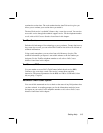
Dell Latitude LT System User’s Guide
7-4
Advanced Menu
Serial Port Sets the RS-232C serial port, selecting the base I/O address. Enabled
means that you can select the item yourself. Auto (default) means that the item is
automatically assigned. Disabled means that you cannot use the port.
IR Port Sets the infrared port, selecting the mode, the I/O channel, the IRQ
channel, and the DMA channel. Enabled means that you can select the items
yourself. Auto means that all the items except the mode are automatically assigned.
Disabled means that you cannot use the port. Set to Auto during normal use.
Mode Specifies the IR mode: IrDA or ASK. Set to IrDA during normal use.
LPT Port Sets the printer port, selecting the mode and the base I/O address.
Enabled means that you can select the items yourself. Auto means that the base I/O
address is automatically assigned. Disabled means that you cannot use the port.
Mode Specifies the LPT port mode: Bi-directional, Output Only, EPP (Enhanced
Parallel Port mode) or ECP (Extended Capabilities Port mode).
Modem Sets the built-in modem, selecting the IRQ channel and the I/O channel.
Enabled means that you can select the items yourself. Auto means that the items are
automatically assigned.
Sound Sets the built-in sound controller. MIDI and Joystick do not work in your
computer even if set to Enabled or Auto.
Internal Pointing Device Enables or disables the glide pad.
Resolution Expansion Defines whether the screen is expanded when the resolution
is 640 x 480. Enabled means that the screen is expanded.
USB Port Enables or disables the USB port. Always set to Enabled; otherwise,
some PC cards may malfunction.
Plug & Play O/S Defines whether the operating system supports the plug & play
function. Set to Yes during normal use.
Large Disk Access Mode Selects the operating system. Set to DOS during normal
use. If you use another operating system such as UNIX
®
, select Other.


















